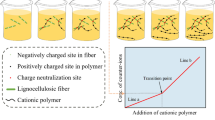Abstract
Total and surface charge of three different carboxymethylated nanofibrillated/microfibrillated cellulose (NFC/MFC) samples were investigated by using titrimetric methods (conductometric and polyelectrolyte (PE) titrations). Conductometric titration was found to be suitable method for the NFC total charge measurements when the back titration with HCl was applied. Surface charge measurements of NFC/MFC were conducted by using both indirect and direct PE titrations. The direct PE titration was found to be a more suitable method for the surface charge determination of NFC/MFC whereas the indirect PE titration produced too high surface charge values. This is presumably due to kinetically locked polyelectrolyte conformations on the NFC/MFC surfaces or entrapment of residual polymer after adsorption onto the NFC/MFC gel network. Finally, NFC was propargyl-functionalized and the changes in surface and total charge were successfully monitored and compared to those of propargyl-functionalized pulp. A good correlation between the titrimetric methods and elemental analysis was observed.






Similar content being viewed by others
References
Chakraborty A, Sain M, Kortschot M (2005) Cellulose microfibrils: a novel method of preparation using high shear refining and cryocrushing. Holzforschung 59:102–107
Filpponen I, Argyropoulos DS (2010) Regular linking of cellulose nanocrystals via click chemistry: synthesis and formation of cellulose nanoplatelet gels. Biomacromolecules 11:1060–1066
Filpponen I, Kontturi E, Nummelin S, Rosilo H, Kolehmainen E, Ikkala O, Laine J (2012) Generic method for modular surface modification of cellulosic materials in aqueous medium by sequential “click” reaction and adsorption. Biomacromolecules 13:736–742
Herrick FW, Casebier RL, Hamilton JK, Sandberg KR (1983) Microfibrillated cellulose: morphology and accessibility. J Appl Polym Sci Appl Polym Symp 37:797–813
Horvath AE, Lindström T, Laine J (2006) On the indirect polyelectrolyte titration of cellulosic fibers. Conditions for charge stoichiometry and comparison with ESCA. Langmuir 22:824–830
Isogai A, Saito T, Fukuzumi H (2011) TEMPO-oxidized cellulose nanofibers. Nanoscale 3:71–85
Johansson L, Tammelin T, Campbell JM, Setälä H, Österberg M (2011) Experimental evidence on medium driven cellulose surface adaptation demonstrated using nanofibrillated cellulose. Soft Matter 7:10917–10924
Junka K, Filpponen I, Johansson L, Kontturi E, Rojas OJ, Laine J (2012) A method for the heterogeneous modification of nanofibrillar cellulose in aqueous media. Carbohydr Polym. doi:10.1016/j.carbpol.2012.11.063
Katz S, Beatson RP, Scallan AM (1984) The determination of strong and weak acidic groups in sulfite pulps. Sven Papperstidn 87:R48–R53
Klemm D, Kramer F, Moritz S, Lindström T, Ankerfors M, Gray D, Dorris A (2011) Nanocelluloses: a new family of nature-based materials. Angew Chem Int Edit 50:5438–5466
Lavoine N, Desloges I, Dufresne A, Bras J (2012) Microfibrillated cellulose—its barrier properties and applications in cellulosic materials: a review. Carbohydr Polym 90:735–764
Littunen K, Hippi U, Johansson L, Österberg M, Tammelin T, Laine J, Seppälä J (2011) Free radical graft copolymerization of nanofibrillated cellulose with acrylic monomers. Carbohydr Polym 84:1039–1047
Moon RJ, Martini A, Nairn J, Simonsen J, Youngblood J (2011) Cellulose nanomaterials review: structure, properties and nanocomposites. Chem Soc Rev 40:3941–3994
Pääkkö M, Ankerfors M, Kosonen H, Nykänen A, Ahola S, Österberg M, Ruokolainen J, Laine J, Larsson PT, Ikkala O, Lindström T (2007) Enzymatic hydrolysis combined with mechanical shearing and high-pressure homogenisation for nanoscale cellulose fibrils and strong gels. Biomacromolecules 8:1934–1941
Saito T, Kimura S, Nishiyama Y, Isogai A (2007) Cellulose nanofibres prepared by TEMPO-mediated oxidation of native cellulose. Biomacromolecules 8:2485–2491
Solala I, Volperts A, Andersone A, Dizhbite T, Mironova-Ulmane N, Vehniäinen A, Pere J, Vuorinen T (2011) Mechanoradical formation and its effects on birch kraft pulp during the preparation of nanofibrillated cellulose with Masuko refining. Holzforschung 66:477–483
Swerin A, Ödberg L, Lindström T (1990) Deswelling of hardwood kraft pulp fibres by cationic polymers: the effect of wet pressing and sheet properties. Nord Pulp Pap Res J 5:188–196
Taniguchi T (1996) Microfibrillation of natural fibrous materials. J Soc Mater Sci Jpn 45:472–473
Turbak AF, Snyder FW, Sandberg KR (1983) Microfibrillated cellulose, a new cellulose product: properties, uses and commercial potential. J Appl Polym Sci Appl Polym Symp 37:815–827
Wågberg L, Winter L, Ödberg L, Lindström T (1987) On the charge stoichiometry upon adsorption of a cationic polyelectrolyte on cellulosic materials. Colloids Surf 27:163–173
Walecka JA (1956) An investigation of low degree of substitution carboxymethylcelluloses. Tappi J 39:458–463
Winter L, Wågberg L, Ödberg L, Lindström T (1986) Polyelectrolytes adsorbed on the surface of cellulosic materials. J Colloid Interface Sci 111:537–543
Acknowledgments
This work was funded by Naseva2 project. Graduate School for Biomass Refining (BIOREGS) and Refining Lignocellulosics to Advanced Polymers and Fibers (PolyRefNorth) network are thanked for personal financial support (KJ). Ms. Gunborg Glad-Nordmark, Ms. Åsa Blademo, Ms. Ritva Kivelä, Ms. Anu Anttila, Ms. Marja Kärkkäinen and Ms. Johanna Mareta are thanked for laboratory assistance. KJ acknowledges fruitful discussions with Ali Naderi and Jonas Sundström (Innventia AB).
Author information
Authors and Affiliations
Corresponding author
Rights and permissions
About this article
Cite this article
Junka, K., Filpponen, I., Lindström, T. et al. Titrimetric methods for the determination of surface and total charge of functionalized nanofibrillated/microfibrillated cellulose (NFC/MFC). Cellulose 20, 2887–2895 (2013). https://doi.org/10.1007/s10570-013-0043-z
Received:
Accepted:
Published:
Issue Date:
DOI: https://doi.org/10.1007/s10570-013-0043-z




